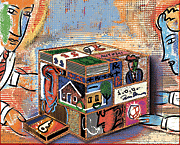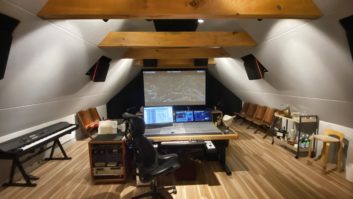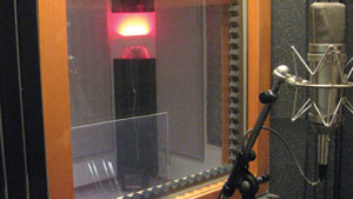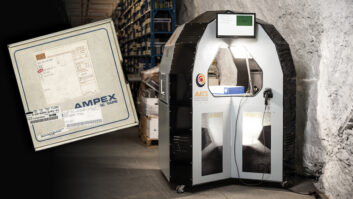
It’s a dominant theme of our times: The deluge of incoming data threatens to overwhelm. Going digital hasn’t helped: A double-edged sword, it has just provided the means to more quickly ingest even more information. Of course, an asset is only an asset if you know you have it, you know where to find it and it’s in a form you can use.
Lots of people are working on digital asset management solutions, from the major computer companies to solo programmers in niche markets. And while some common attributes of data management are necessary to almost anyone, to be really effective, a system needs to be personalized to its users; hence, the plethora of home-grown systems. The problem that’s rearing there is incompatibility — the terrifying specter of having to convert, at some point, all of an entity’s data to yet another system.
Today, open-architecture systems are coming into favor, with modular components that make them cost-effective. Here, Mix touches base with some companies offering digital asset management systems for music, film and radio.
GETTING A HANDLE ON MUSIC AND SOUND EFFECTS
Entertainment production facilities for film, television, radio and advertising have a voracious appetite for sounds and music. Los Angeles — based mSoft Inc. (www.msoftinc.com) offers custom solutions that are in use by such facilities as CBS, the WB Network, Pacific Ocean Post, Electronic Arts and Saatchi & Saatchi advertising.
“We’re a browser-based, Intranet media-management system,” says Doug Perkins, mSoft’s VP of sales and marketing. “Our systems use Internet TCP/IP standards to provide a secure local system within a facility or across multiple facilities. A producer sitting at his desk, for example, who needs to find music for his spot uses his browser to access a server IP address in the machine room. He can audition in real time and transfer files to his work environment in the format required.
“Usually,” Perkins continues, “a large music and sound effects user gives us lists of the CD libraries they’re using. We determine how big a system they’ll require, and we generally provide a system 25 percent larger than that to allow for future library updates. Then we install servers, backed up by Level 5 RAID (Random Array of Independent Disks). We currently have about 15 terabytes of digitized music and sound effects libraries, from the big companies and also boutique houses. We provide [our clients] with digitized versions of whatever CD libraries they’re licensed to use, including the metadata — the search text — as well as the audio files. After that, we update them every month via hard drive with new music. If they have a sound design library of their own with a commonly used text database like Excel or Filemaker Pro, we can import that, as well.”
A basic premise of mSoft’s systems is that the company is platform-independent. “It works with Mac, PC, Unix, SGI, et cetera, with virtually any DAW,” explains Perkins. “If they’re using Pro Tools, they can download to sessions or timecode locations. Within the system, they make projects — lists of effects and music that they want to use in a session — that they can batch transfer to their Pro Tools session, Avid audio drive folder, Final Cut Pro, et cetera.”

The PIX system allows sharing of notes, schedules and edited material, with integrated secure Web access
The password-protected mSoft systems recognize edits, read edit lists and generate timesaving automatic cue sheets. (mSoft is currently working to provide cue sheets that the performance rights organizations ASCAP and BMI will accept.) Recently introduced is mSoft MusicDirector, an innovative music search product that circumvents metadata inaccuracies, language barriers and standardization issues by using a sample track to do an actual audio search rather than a metadata search for similar music.
mSoft sells complete systems and subscriptions that Perkins calls “similar to the cable TV model,” where the local hardware system is leased, with software and content updates provided. The company has also branched out into video libraries. “The ultimate goal,” says Perkins, “is to have a media ‘Library of Congress’ containing everything a company might need to use and reuse in a production environment: music and sound effects, voice-over recordings, video, logos, fonts — all of it. The time has come for the media management to catch up to the progress that’s been made in the editing environment with the DAW.”
STEM TO STERN PROJECT MANAGEMENT
The concept for PIX (Production Information eXchange) evolved when computer-savvy sound editor Eric Dachs was working on the movie Panic
Room. Searching for a way to use the Internet for real-time collaboration on sound effects spotting sessions, Dachs teamed up with fellow sound editor Larry Schalit, designer Jules Bowie, and engineers Craig Wood and Erik Bielefeldt to design what’s now become a complete project-management system. PIX allows the sharing of notes, schedules and edited material, and integrates secure Web access with modular applications for screening and annotating dailies, spotting sessions, location scouting, casting, scoring and more.
At press time, PIX was in use on the film Jarhead (among other projects) by director Sam Mendes, editor Walter Murch and sound supervisor Pat Jackson. “Sam shoots, Walter gets the dailies, cuts a scene and puts it up on PIX,” explains Schalit. “Sam gets an alert, downloads the scene to his laptop in his hotel room and can go back on the set knowing how his approach is working. Pat can spot a reel, then Walter, the sound editors, Sam — or whoever is designated in the permission system — gets a ‘virtual’ reel from her and can send back comments.”
One of the system’s features is that a timeline of edited media accumulates over the entire project as participants add to it from script to final mix. Says Dachs, “Different portions of the application can collect information from the time a film goes into development: stills from locations, music, research materials, et cetera. As the film progresses, we’re building an entire active record of all of its digital assets. An age-old problem this addresses is that making a film is very segmented. Pre-production is its own environment versus production and post. Re-ingesting information that’s happened upstream wastes a lot of time. We believe that a piece of information only needs to be entered once.”
PIX’s core is a browser-based open platform. “As sound editors, we’ve been the victims of workstations with closed environments,” says Dachs. “PIX is an application service provider, and we have a comprehensive API. [Ed note: An application service provider, or ASP, provides access to application programs via the Internet for a fee.] If you have a particular way of organizing your sound files that works really well in your Filemaker database — depending on how it’s put together — you can attach your database to the PIX framework and get information in and out.”
Getting busy filmmakers to adopt new technology isn’t easy. “One of the positive outcomes of having a PIX system in place throughout a production,” comments Schalit, “is that we can suggest naming conventions, where, because so many people are independent contractors, there wasn’t that infrastructure before. Also, because PIX can store comprehensive descriptions and catalog all kinds of metadata that are helpful to searching, the original file name becomes less important.”

Dalet director of product development Eric Richardson
Dachs and his group see PIX as a universal production platform for film, television, advertising and videogaming. “We’re trying to transition hours that are now spent on administration back into the creative area,” says Dachs. “Files and metadata are part of it, but ultimately, PIX is a tool that makes it easier for people to connect with ideas and with each other.”
BY SOUND EDITORS, FOR SOUND EDITORS
Started by sound editors at a post-production house in Toronto, Ontario, the Soundminer audio file management system was released commercially in January 2002. “We didn’t build this with the intent to make a commercial product. We built this internally for our facility because we didn’t like anything available at the time,” says Soundminer’s Steve Pecile.
“The way the system is built,” Pecile describes, “the database travels in a file with the descriptive information in a wrapper. There are two main portions to the system. Ripper is the application that allows you to transfer commercial sound effects and music audio CDs into the most common formats, with all the database information, the waveforms and the search metadata embedded in the resulting file. Then you drag-and-drop it onto Soundminer and it auto-builds a database for you. Soundminer is also a waveform editor and audio plug-in host: You can edit and add effects and then place the newly created sound on a specific track and time location within Pro Tools or Nuendo. With ReWire implementation, you can control your DAW and monitor through your DAW’s hardware at any sample rate.
“Ripper gives the user a number of ways to name a file,” continues Pecile. “Beyond the name, because there are only so many open standards for metadata, some of the metadata containers are proprietary. For example, Macintosh uses Finder Comment as a metadata container and Broadcast .WAV uses Bext. We support those and MP3 id3 tags so that you can at least see them, even if you don’t have Soundminer. For example, if you were working on Pro Tools — which supports both Broadcast .WAV and Bext, as well as Finder Comment — by simply ripping with our program, you would see a full description above and beyond the name of the file. If they also had Soundminer, they would have extra containers: who composed it, who published it, what category it falls into, et cetera. You can also modify existing descriptions and store your own descriptions.”
Soundminer so far is a hybrid between proprietary and open architecture; the products were developed for Macintosh OS 9 and OS X, but scheduled to debut at this month’s AES show are Windows XP versions. Soundminer products range from a stand-alone Ripper/Soundminer LE “light” edition bundle, appropriate for a single editor to use, and a full Soundminer 3 version with extensive sound design capability and other features, to a server system that expands to work with multiple clients from a central location.
The company is currently collaborating with production music companies to help replace CD delivery of their libraries with metadata-embedded digital files. “People are shooting 24-bit/96k sound,” notes Pecile. “Sound effects editors are working in higher resolution. They want to be able to deliver in those formats as well, and Soundminer is capable of playing up to eight channels of 192k sound.”
PRODUCTION AND WORKFLOW
With such customers as XM Satellite Radio, NPR, Voice of America and the Canadian Broadcasting Corporation, Dalet Digital Media Systems provides media-management tools to large companies, including systems — such as DaletPlus RadioSuite — that combine workstation technology with database management.
Dalet was started by computer scientists with the notion that what broadcasters needed was centrally stored media accessed via a network that could provide instant access to it in real time. “The core,” comments director of product development Eric Richardson, “was the concept of a database and central storage where users share only one copy for production and playout, with browsing purposes accessed over the network. Today, that’s done using standard Internet tools.”
With digital files stored in servers and other places where they can’t actually be seen, the primary goal of an asset-management system is to have a way to search and retrieve. Increasingly, it’s also necessary to be able to repurpose those assets.
“For our clients, that means re-editing a file and putting it back on the air or the Web,” continues Richardson. “For the broadcast industry, a system that works purely as an archive isn’t enough. We need production tools that let users manipulate the content and keep track of it. The first element of going digital meant perfect reproduction, but the real advantage is how it impacts workflow. That’s the revolution that asset management brings: the potential for changing the way people work.
“For example, at XM Radio, they have over 2 million song titles online. The same copy of a song can be playing on three different channels, all simultaneously streaming off the server. DJs can do searches and what they’re looking for instantaneously comes up on their workstation. They can edit it and create a show, and it’s all nondestructive, using just one copy of the media.”
Although a large part of Dalet’s systems involve automation, there are also numerous live applications. According to Richardson, “For XM and our other radio customers, especially on news programs, they can be editing a piece and still finishing the back end while the front end is going on the air. That’s one of our most powerful concepts: While something is coming in, users can be working on it and pulling sound bytes, et cetera. The reverse is also true: While you’re still finishing the editing, you can start to broadcast.
“Asset management means many things to many people. The context for broadcast and for audio and video content producers includes not just storage, but manipulation and communication of the data,” Richardson continues. “The heart of all that is a powerful database that can keep track of where everything is stored physically. When you have hundreds of users who want to be able to access the material from a roomful of servers, you need something on top of that to make the actual physical location of the file transparent to the user.
“XM, for example, couldn’t exist in its current form without a system like Dalet. They provide over 100 channels, 24-hours-a-day, with very high production values. They have Pro Tools rooms, but they also have 350 desktops running the Dalet editor pulling material off the servers.”
Effective file naming, of course, is a key component to any kind of digital asset management. Numerous organizations are working on standardized metadata-naming conventions, but progress has not been fast. Meanwhile, the all-too-familiar problem of getting manufacturers to agree on standards is ongoing.
“Transferring is the easy part; harder is entering metadata,” Richardson admits. “What do you call it, how do you describe it, how do you make it searchable? The Achilles heel of all this is that a system is only as good as the metadata in it. It has to be entered with a consistent vocabulary. Broadcasters and other organizations are coming up with metadata schemas and beginning to standardize the parameters.
“XM has original content and music to keep track of, so they have their own system with over 125 different data fields associated with it: things like album art, front and back scans of the CD, liner notes in both high and low resolution for the Web. All that labeling from the database is sent out to the satellite and then comes down to your car where you have the text scroll. In a way, XM is the poster child for how asset management affects so many parts of a business: what you see on the Website, your receiver, the information the DJs use to talk about the material and song reporting for the publishing industry.”
Backup formats are, of course, another crucial area in which standards are still being debated. “Especially for news content, it’s very important for broadcasters to be able to type in a few keywords and access their archives,” Richardson asserts. “But what format do we currently have that’s going to last 50 or 100 years? There’s no good answer. We have practices and recommendations, but what we stress is that in the future, you are going to have to keep migrating your archived media. Today the format may be tape, tomorrow it may be optical, 20 years from now it may be something we don’t even know about.
“An archive system is expensive, so it’s difficult to think it may only last 20 years. Historically, things were archived to vinyl or tape, with the belief that that was it; it was done. But now there is no ‘done.’ But as long as you have your content in an open system database that isn’t stuck in a proprietary way, it can be exported and translated and you can keep moving forward. You’re going to be doing that from now on, and with a good asset-management system, the cost to move things forward will be less.”
Companies are making huge investments in managing their content because they know it’s a huge part of their future. Concludes Richardson, “Large broadcasters — Fox, CNN, NPR and other organizations with large audio/video libraries — are realizing that their content is a giant treasure trove that’s increasing in value every day. It has to be easily searchable to exploit that value, and it also has to be able to be manipulated because the back side of an asset-management system is repurposing and commerce.”





